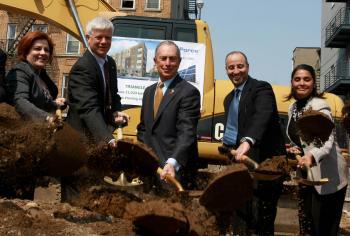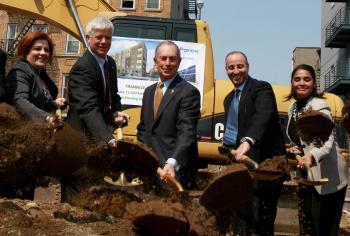NEW YORK—Vacant lots punctuate the city’s streets. Some of them, known as “brownfields,” remain barren and underutilized because environmental contamination would make development too complicated. City Council Speaker Christine Quinn estimates that across the five boroughs they cover more than 7,000 acres.
On Monday, the city broke ground on a brownfield cleanup at 456 Grand St., in Williamsburg, Brooklyn. The cleanup is part of the first municipally run brownfield reclamation program in the nation.
The city provides incentives to developers for undertaking the costly venture. A project could be awarded anywhere from $60,000 to $140,000. More importantly, says Quinn, the city relieves the developer of any liability should future problems arise related to contamination. With these incentives in place, the city hopes to see lots like 456 Grand put to good use in the near future.
“There used to be a theater there,” recalled Peter Ruiz, 60, born and raised in the area. He looked upon the vacant Grand Street lot and continued to reminisce, “A lot of celebrities would come here. Then when the theater closed, a gas station moved in. There wasn’t much service there, that’s why it closed. It was more of just a hangout for the little gangs.”
The gas station left behind an estimated 4,500 tons of moderately contaminated soil. Underground tanks caused the contamination. The cleanup crew will have to dig 12 to 14 feet down and haul the soil to a treatment center in New Jersey.
On Monday, the city broke ground on a brownfield cleanup at 456 Grand St., in Williamsburg, Brooklyn. The cleanup is part of the first municipally run brownfield reclamation program in the nation.
The city provides incentives to developers for undertaking the costly venture. A project could be awarded anywhere from $60,000 to $140,000. More importantly, says Quinn, the city relieves the developer of any liability should future problems arise related to contamination. With these incentives in place, the city hopes to see lots like 456 Grand put to good use in the near future.
“There used to be a theater there,” recalled Peter Ruiz, 60, born and raised in the area. He looked upon the vacant Grand Street lot and continued to reminisce, “A lot of celebrities would come here. Then when the theater closed, a gas station moved in. There wasn’t much service there, that’s why it closed. It was more of just a hangout for the little gangs.”
The gas station left behind an estimated 4,500 tons of moderately contaminated soil. Underground tanks caused the contamination. The cleanup crew will have to dig 12 to 14 feet down and haul the soil to a treatment center in New Jersey.







